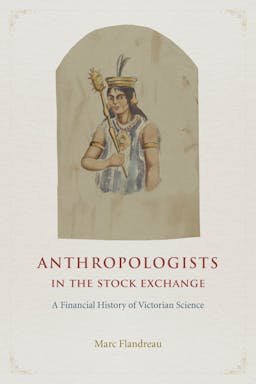
Book Review
Anthropologists in the Stock Exchange: A Financial History of Victorian Science, 2016
By Marc Flandreau
In Anthropologists in the Stock Exchange, Marc Flandreau has presented an interesting account of historical intersections through the tangled web of finance, science, elites and imperialism. The multiple characters, learned societies and locations discussed give the reader a sense of the broad scope behind the rise of the Anthropological Society and the shifting foci of informal empire. Flandreau incorporates a range of documents from the rich archives of the learned societies and official council and parliamentary papers to illustrate the various links between science, government and finance (also included are a number of supplements which further explore primary material pertaining to Bedford Pim, 281 ff.). The diversity of subjects, sources and characters introduced in this study is a rather piecemeal account of interconnected, but not always fluid, themes. The book begins with a redress of current perceptions of anthropology in the Victorian era and importantly, highlights the link between foreign bond holders and anthropologists. By illuminating this connection as well as key figures within the realm of anthropology and exploration in Chapter Three, ‘Rise of Cannibal’, the author acknowledges several critical gaps in historians’ understanding of Victorian science.
The book continues by looking at the evolution of the Anthropological Society alongside the Ethnological Society of London and the Royal Geographical Society. Highlighting key differences in membership, for example Ethnologists described as the ‘inner circle of old wealth’ (p. 61), Flandreau signifies important and complex development pathways. By presenting the enmeshed histories of these three societies, the author acknowledges important member networks (both internal and external) which were common in many of the learned societies of the nineteenth century. From chapter four, the book turns outwards to examine the foreign activities of bond holders, governments and key members of the Anthropological Society. Amongst these chapters is a more complex discussion of the nature of truth and trust within anthropological history through the concept of bona fide (chapter six), in keeping with the medley structure of this book. The final chapters similarly touch on a range of topics, the misunderstood characters Bedford Pim (chapter eight) and Hyde Clark (chapter ten), informal empire in action and the complex relationship between knowledge and ownership. It is an exhaustive study in its breadth, a patchwork, which although identified at the outset by the author, does prove a complex and sometimes confusing read. The stitching together of various themes, topics and characters, to some extent, takes away from the book’s rigour, but many of the connections made by Flandreau are important ones.
Most significantly, the connections made are ones which allow the reader to ponder the interwoven nature of nineteenth century learned societies, informal empire and, though less emphasised in the core of the text than expected, finance. Most interesting of these connections, to business historians in particular, is the relationship between ‘puffing’ (or promotion as it has been termed in other studies), ‘white-collar crime’ and anthropology. Promotion, which is emblematic of new ventures of the Victorian period, has often been aligned with foreign (and domestic) projects such as new railways and mining opportunities. In this study, Flandreau shows us a world beyond the British railway mania and Gold Rush, on which there are a number of significant works already written (on the railway mania, see Bryer, 1991; Lewin, 1936;. Reed, 1975; for gold rushes in both California and Australia, see Woodland, Money Pits, 2016). However, unlike some of these studies, the complexity of promotion, finance and the intricate financial networks are not explored in as much detail as the reader might expect given the title.
Another connection made in the monograph which is important for contextualising the reach of anthropologists into a number of networks are the links made between the Society, foreign bond- holders, railway men in locations like Honduras and foreign governments. This provides the reader with an interesting perspective on informal empire through the lens of science. That said, the cobbled together nature of the themes, sources and overall arguments is at times troublesome; as is the lack of depth in discussion of the nature and character of financial relationships. Some of the most significant financial data and discussion are (surprisingly) found in the final two supplements (pp. 295-305). To remain true to its title, this information would have been better placed throughout a couple of chapters dedicated to discussing the business of science and of anthropological ventures in particular. This is not necessarily a negative aspect of the book but readers, and in particular business historians, looking for a probing study into the complexity of financing scientific work and company promotion may not find such discussions here. Criticisms from the perspective of a business historian aside, Flandreau has undoubtedly delved into a wealth of rich archival sources. In many ways, he has redressed the evolution of learned societies, conceptions of Victorian racism and important links to governments, both in Great Britain and abroad. From this, Flandreau has drawn some important conclusions regarding knowledge, ‘truth’ and the structures of informal empire.
Emily Buchnea
Northumbria University